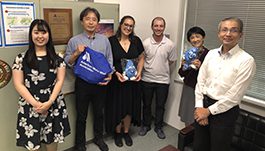Honeymoon to Tokyo nurtures AWWA relationship with Japan water association
April 2, 2025

AWWA Articles
Honeymoon to Tokyo nurtures AWWA relationship with Japan water association
An American Water Works Association (AWWA) staff member’s honeymoon in Tokyo doubled as an opportunity to nurture AWWA’s longstanding relationship with the Japan Water Works Association (JWWA).
Dr. Veronica Cavera, AWWA’s education and workforce manager, and her husband, Ryan, visited Japan in October 2024, where Cavera met with JWWA leaders to advance collaborative efforts between the two organizations.
“We discussed how AWWA has access to people and regions that JWWA would like to be part of but does not quite have the pull to do so,” Dr. Cavera said. “We also had time to have a traditional meal and chat about the kinds of content each office makes to support operators and the public. JWWA develops excellent training materials to improve public understanding of water systems.”

Collaboration is integral to solving global water challenges, and AWWA is partnering with the JWWA, Chinese Taipei Water Works Association and the Water Research Foundation on the November 2025 International Seismic Conference in Taipei, Taiwan.
AWWA is also collaborating with JWWA to train emerging water leaders like Sakura Yamada.
“I think it is important to think about how to make effective use of these resources and continue to supply people with safe and secure water,” Yamada said via video. “To achieve this, it is necessary for both the United States and Japan to share common challenges and solutions, such as climate change, facility renewal and operation, water quality issues, and human resource development. Therefore, we believe it is necessary to continue the regular exchange of information between AWWA and JWWA. We hope that the exchange of information will continue to contribute to the development of the water industry in each country.”
Cavera noted that mascots are popular in Japan, so Eddy – AWWA’s water-drop character — is a celebrated icon in the JWWA office.
While in Japan, Cavera also visited Kawagoe, known for traditional metal buildings – as well as sweet potato dishes. She came across a manhole cover showing the city’s emblem and matoi banners, which firefighters used during the Edo period. Another manhole cover in the area depicted the city’s mascot — a Japanese sweet potato — as a firefighter.

Throughout Japan, designer manhole covers artfully inform people about the sewer system. The designer manhole covers first appeared with “happy fish” as part of a public relations campaign in 1977 in Naha City. Today, these covers feature artwork showcasing characteristics of different regions, such as one in Hiroshima that displays the Hiroshima Castle. Others feature pop culture figures like Pokémon.
Nearly 95% of Japan’s 1,718 municipalities have their own unique manhole covers. The manhole covers are used to revitalize local areas and are utilized as assets for tourism. They have become so popular that there are trading cards available at wastewater facilities for collectors.
